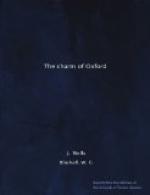“The high embowed roof
With antique pillars
massy proof,
And storied windows
richly dight,
Casting a dim religious
light”
of the “Royal Saint’s” great chapel at Cambridge.
MAGDALEN COLLEGE (2) HISTORY
“Sing sweetly, blessed
babes that suck the breast
Of this sweet nectar-dropping
Magdalen,
Their praise in holy
hymns, by whom ye feast,
The God of gods and
Waynflete, best of men,
Sing in an union with
the Angel’s quires,
Sith Heaven’s
your house.”
SIR
J. DAVIES.
Magdalen College was founded by William of Waynflete, Bishop of Winchester, who had been a faithful minister of Henry VI. He had served as both Master and Provost of the King’s own college at Eton (and also as Master of Winchester College before), and from Eton he brought the lilies which still figure in the Magdalen shield. As a member of the Lancastrian party, he fell into disgrace when the Yorkists triumphed, but he made his peace with Edward IV, whose statue stands over the west door of the chapel, with those of St. Mary Magdalene, St. John the Baptist, St. Swithun (Bishop of Winchester), and the Founder. And the Tudors were equally friendly to the new foundation; Prince Arthur, Henry VIII’s unfortunate elder brother, was a resident in Magdalen on two occasions, and the College has still a splendid memorial of him in the great contemporary tapestry, representing his marriage with Catharine of Aragon.
To the very early days of Magdalen belongs its connection with the Oxford Reform Movement and the Revival of Learning. Both Fox and Wolsey, successively Bishops of Winchester, and the munificent founders of Corpus and of Cardinal (i.e. Christ Church) Colleges, were members of Waynflete’s foundation, and so probably was John Colet, Dean of St. Paul’s, whose learning and piety so impressed Erasmus. “When I listen to my beloved Colet,” he writes in 1499, “I seem to be listening to Plato himself”; and he asks—why go to Italy when Oxford can supply a climate “as charming as it is healthful” and “such culture and learning, deep, exact and worthy of the good old times ?” Erasmus’ praise of Oxford climate is unusual from a foreigner; the more usual view is that of his friend Vives, who came to Oxford soon after as a lecturer at the new college of Corpus Christi; he writes from Oxford: “The weather here is windy, foggy and damp, and gave me a rough reception.”




